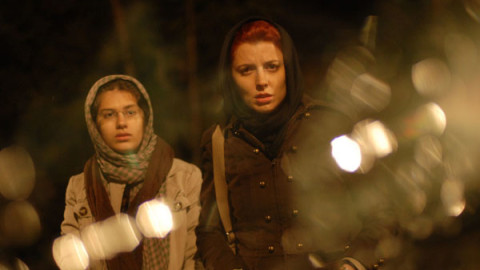Review: Mud

Mud is grounded in that awkward moment of youth where you begin testing out things you’ve seen adults do on TV—swearing, kissing, saving the day by following your heart—and quickly discover that the world doesn’t work quite that easily. And, with the exception of certain aspects of its denouement, the film, written and directed by Jeff Nichols, avoids the clichés and easy answers that most coming-of-age stories peddle and instead shows the abundance of humor, frustration, and sadness that is part and parcel of this tender age.
The film opens with Ellis (Tye Sheridan) and Neckbone (Jacob Lofland) sneaking off to a tiny island where a modest cabin cruiser hangs on the top branches of a tree after a flood, every other word of their terse, posturing exchanges a “shit,” “damn,” or “fuck.” This quintessentially surreal—or surruralist—image of the boat leads into the central mystery of the film: Mud (Matthew McConaughey), a leathery, leisurely man, lives in the boat, and is trying to survive in the wilderness long enough rendezvous his sweetheart, Juniper (Reese Witherspoon).
Mud’s twisty grin, the pistol tucked into his waistband, and his drawling charm are irresistible to the boys who ordinarily spend their free time helping relatives with their fishing business and hanging out in parking lots, watching cute girls from a safe distance. Ellis, the older boy, falls hardest and most unswervingly for Mud, especially when his parents’ marriage begins to fall apart. Instead of eating dinner around the table like a family, he eats beanie weenies out of the can with Mud round the fire and listens to stories of Juniper’s mythic love. For Ellis, and Neckbone, women are both the cause of, and solution for, all of life’s problems.

But when Ellis and Neckbone encounter a bruised, daisy duke-wearing Juniper at the Piggly Wiggly, they begin to understand the situation differently: Mud murdered her abusive ex, which is why he’s been hiding on the river, and now the dead man’s family has bounty hunters after him to exact vengeance. Staying true to their youthful (and aspirationally manly) ideals, the boys extend their support far beyond delivering canned goods and collect large swaths of scrap metal and tar to make the boat in the tree seaworthy. As Ellis continues to gather more information about the people in Mud’s life—Juniper, a grumpy neighbor who once served as Mud’s guardian, and even the men who are after him—he learns that every adult is just as complicated as he is. They’re no longer simply lumbering jerks who only punish or instruct; they are real people who have loved something at least once, and have lost something many more times.
This effortless way in which the mystery’s various components are tied to the realities of growing up is undoubtedly the film’s greatest strength. These multifaceted characters genuinely develop, and the regionally specific dialogue rings true. The film’s moral complexities are writ in small details, as when a group of burly bounty hunters briefly “take a knee” in a hotel room to pray for Mud’s death, at the insistence of their employer. Nichols visually encapsulates small town life perfectly: seeing the world from the back of a pickup truck, crawling down the town’s main drag; or speeding up a river, trees on either side, blue skies overpowering the small figures below. These are kids that get 10 bucks for their allowance and permission to use their uncle’s old dirt bike, not iPods for Christmas.
The absence of the likes of Ellis and Neckbone from recent independent film troublingly underlines the limitations of distributors who seem to feel as though they intimately understand what does and does not interest audiences, indie or mainstream. In its energy and nuance, Mud seems like the kind of film Hollywood would’ve made in the Seventies, and would’ve continued to do if not for the advent of market-conscious filmmaking. Though it wouldn’t be playing in Dumas or Stuttgart, Arkansas (where it was filmed), if it hadn’t been filmed there, the fact that Mud exists—and is so endearing—bodes well for Southern-based productions, and the medium itself.




